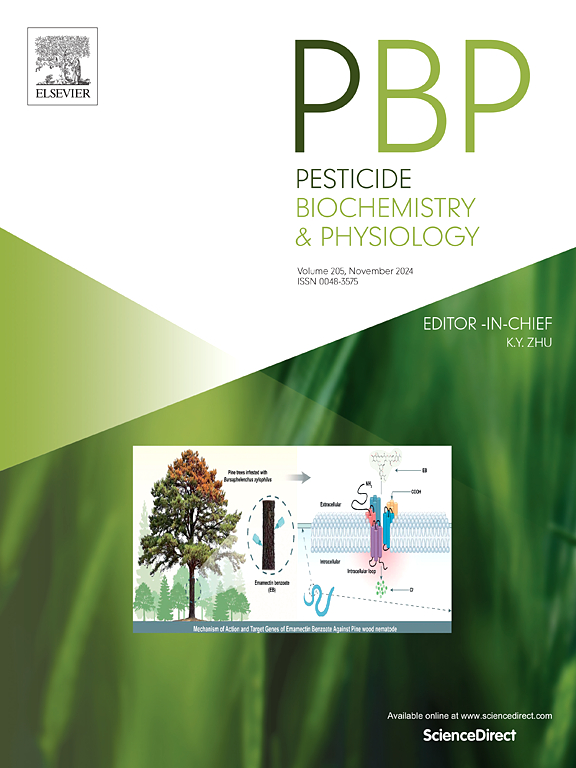Transcription factor MaAP-1 regulates conidiation patterns via YAP domain binding to the MaPom1 promoter in Metarhizium acridum: Implications for enhancing fungal biocontrol efficiency
IF 4
1区 农林科学
Q2 BIOCHEMISTRY & MOLECULAR BIOLOGY
引用次数: 0
Abstract
Entomopathogenic fungi such as Metarhizium acridum are pivotal for sustainable pest management, yet the industrial conidial production is hindered by low yields and environmental sensitivity. Transcriptional regulation provides key targets for engineering strain modification. AP-1 transcription factors (TFs) are well-known for their roles in fungal growth, development, conidiation, pathogenicity and stress tolerance across various fungi. However, the structural and functional roles of AP-1 TF and its regulatory mechanisms in conidiation pattern shift (CPS) remain unexplored in M. acridum. In this study, MaAP-1 was identified as a nuclear-localized transcription factor. Deletion of MaAP-1 or its YAP domain accelerated conidial germination, increased conidial yields, impaired stress tolerance, and reduced pathogenicity. MaAP-1 also served as a regulator of conidiation pattern shift (CPS), shifting microcycle conidiation (MC) to normal conidiation (NC) on SYA medium. Yeast one-hybrid (Y1H) and electrophoretic mobility shift assays (EMSA) revealed that the YAP domain of MaAP-1 directly bound to the motif (TTAGTAA/TTACTAA) in the MaPom1 promoter to regulate CPS, and molecular docking predicted the critical residues (ILE-210, THR-211, THR-212, Glu-213, Gln-216, LYS-218) in YAP domain to mediate this process. Overall, these findings highlight roles of MaAP-1 and its domain in conidial development, stress resistance, pathogenicity, CPS and provide novel insights into the molecular mechanisms underlying CPS. This work lays a theoretical foundation for strain improvement and fungal pesticide optimization to meet the demands of sustainable agricultural development.

转录因子MaAP-1通过YAP结构域与Metarhizium acridum的MaPom1启动子结合来调节分生模式:对提高真菌生物防治效率的意义
像绿僵菌这样的昆虫病原真菌是害虫可持续治理的关键,但工业分生孢子的生产受到产量低和环境敏感性的阻碍。转录调控是菌株工程修饰的关键靶点。AP-1转录因子(TFs)在真菌的生长、发育、分生、致病性和各种真菌的耐受性中发挥着重要作用。然而,在M. acridum中,AP-1 TF在条件模式转变(CPS)中的结构和功能作用及其调控机制尚不清楚。在本研究中,MaAP-1被确定为核定位转录因子。MaAP-1或其YAP结构域的缺失加速了分生孢子的萌发,增加了分生孢子的产量,降低了对逆境的耐受性,降低了致病性。MaAP-1还能调节SYA培养基上的分生模式转变(CPS),将微循环分生(MC)转变为正常分生(NC)。酵母单杂交(Y1H)和电泳迁移率转移(EMSA)实验结果显示,MaAP-1的YAP结构域直接结合MaPom1启动子的基序(TTAGTAA/TTACTAA)调控CPS,分子对接预测了YAP结构域中介导这一过程的关键残基(ILE-210、THR-211、THR-212、Glu-213、Gln-216、LYS-218)。总的来说,这些发现突出了MaAP-1及其结构域在分生孢子发育、抗逆性、致病性和CPS中的作用,并为CPS的分子机制提供了新的见解。本研究为菌种改良和真菌农药优化,满足农业可持续发展的需要奠定了理论基础。
本文章由计算机程序翻译,如有差异,请以英文原文为准。
求助全文
约1分钟内获得全文
求助全文
来源期刊
CiteScore
7.00
自引率
8.50%
发文量
238
审稿时长
4.2 months
期刊介绍:
Pesticide Biochemistry and Physiology publishes original scientific articles pertaining to the mode of action of plant protection agents such as insecticides, fungicides, herbicides, and similar compounds, including nonlethal pest control agents, biosynthesis of pheromones, hormones, and plant resistance agents. Manuscripts may include a biochemical, physiological, or molecular study for an understanding of comparative toxicology or selective toxicity of both target and nontarget organisms. Particular interest will be given to studies on the molecular biology of pest control, toxicology, and pesticide resistance.
Research Areas Emphasized Include the Biochemistry and Physiology of:
• Comparative toxicity
• Mode of action
• Pathophysiology
• Plant growth regulators
• Resistance
• Other effects of pesticides on both parasites and hosts.

 求助内容:
求助内容: 应助结果提醒方式:
应助结果提醒方式:


